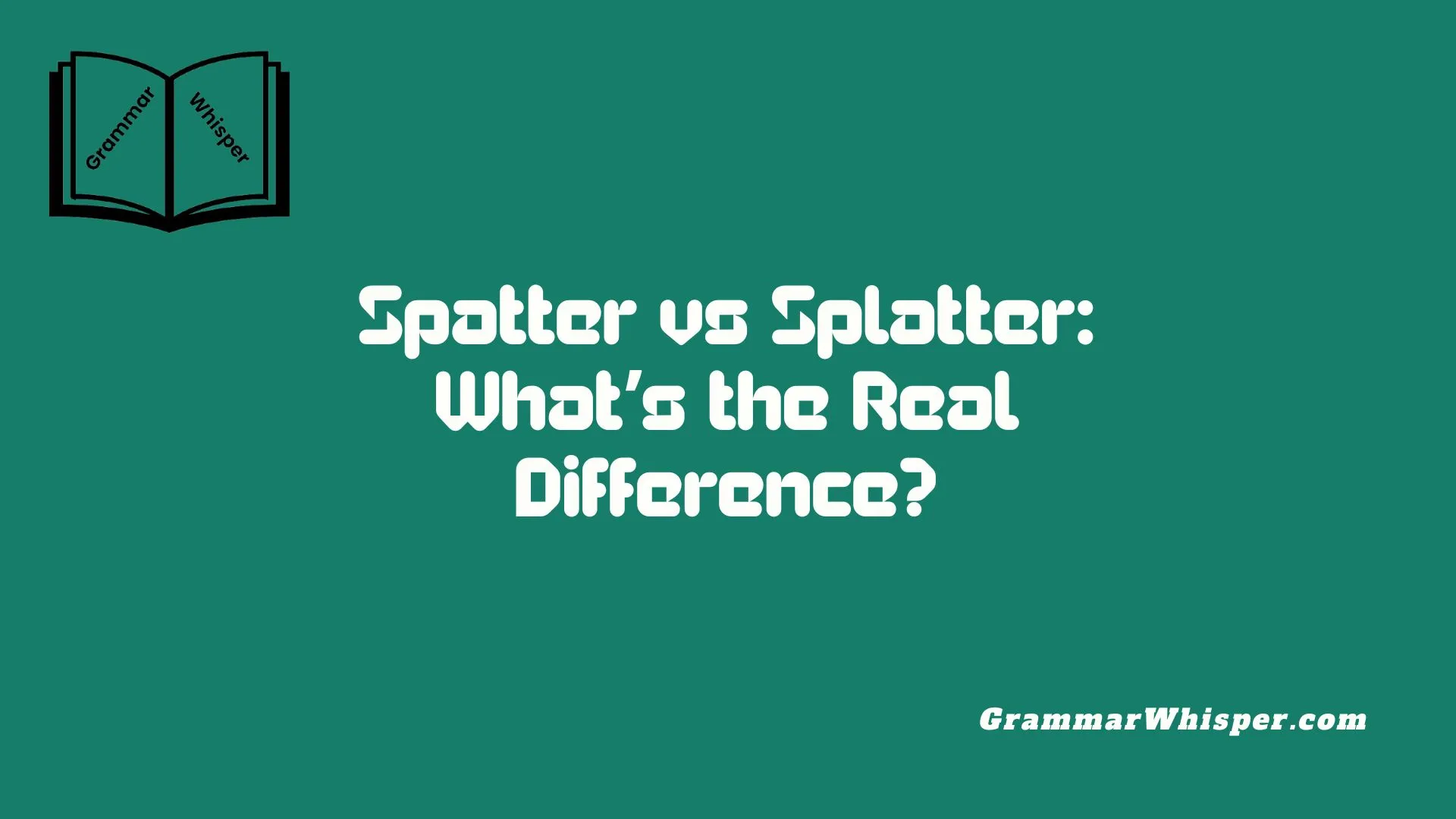When I was writing reviews for a horror films and design blog, I noticed how often directors mixed up Spatter vs Splatter. At first, I thought it was just a style thing, but the difference really matters. If you’re writing about a crime scene, a small detail like blood spatter can shift the entire forensic analysis. Meanwhile, splatter works best when paint bursts across a canvas or art piece in a dramatic set design. These subtle differences in meaning, visuals, and intensity can completely change your message. As writers, designers, or analysts, our credibility depends on using the right language – not just for style, but for function. I’ve seen real examples where a single word affected how a scene was read or interpreted.
Digging into the historical evolution of the two terms helped me see why their usage matters. Over time, spatter became tied to forensic and crime reporting, while splatter landed in the world of visual art and media. Older definitions and imagery show how the descriptive voice of English became more nuanced. Today, we have distinct uses for both thanks to real-world, practical applications in law and storytelling. I keep a cheat sheet and tables handy when working on visual copy or reviewing case studies. Whether it’s a small choice, a quick tip, or just a helpful habit, that attention to detail creates the kind of precision in communication that sets you apart. Once you stop splitting hairs and really get the meanings, you start to expect more clarity in every project.
Definitions: What Do “Spatter” and “Splatter” Actually Mean?
Let’s nail down how these words differ in everyday English:
| Term | Definition (Verb) | Definition (Noun) |
| Spatter | To scatter drops lightly, often small and intermittent | Fresh drops or marks scattered in small quantities |
| Splatter | To splash or scatter liquid forcefully and richly | Large splash marks or messy droplets |
Key Differences
- Size & spread: Spatter implies small droplets; splatter screams volume and mess.
- Force & intent: You spatter gently or unintentionally; you splatter with impact.
- Usage context: Writers use spatter for subtlety; artists and horror genres lean into splatter.
Etymology and Evolution: How These Words Developed Over Time
Tracking back centuries, these terms come from distinct origins:
The Roots of Spatter
- Derived from Middle English spattern, linked to Dutch spatten – “to scatter drops”
- Used by scholars, describing rain drumming on roofs or cooking splashes through cookbooks
The Emergence of Splatter
- A newer variant from 17th–18th century English, likely onomatopoeic: splash + spatter
- Cemented in popular culture with the rise of splatter films in the 1970s–’80s
This progression shows language adapting with changing needs, from describing raindrops to cinematic gore.
Real-Life Examples and Usage in Context
To see these words in action, here are examples drawn from literature, media, and everyday speech:
Literary Usage
“He spattered ink across the map’s margins.” – Author A, Islands of Midnight.
“The painter splattered bold strokes of crimson across the canvas.” – Author B, Modern Minimalism.
Film and Media
- Blood Spatter Analysis: A forensic staple in shows like CSI, where experts study droplet shape, size, and angle to reconstruct violent events
- Splatter Films: Subgenre of horror cinema like Blood Feast (1963) or Evil Dead (1983), known for extravagantly messy gore and visual shock
Everyday Use
- Spatter: “Mom spilled sauce and spattered the kitchen wall.”
- Splatter: “He dropped the paint bucket and it splattered all over the floor.”
Visual Comparison: What You Picture When You Hear the Words
Seeing is believing. Imagine two scenes:
- Spatter: Tiny droplets hitting a surface – ring-size varied, fine, irregular. Think raindrops on a window pane or cooking splashes when frying.
- Splatter: Thick globs, sprayed in all directions with impact. Think of a red tomato exploding on concrete or crime scene photos with dramatic blood patterns.
Visual Characteristics
| Feature | Spatter | Splatter |
| Droplet size | Small, varied (1–3 mm) | Large droplets or globules (>5 mm) |
| Distribution | Light, often distant from the origin | Dense, close-to-source messy marks |
| Force implied | Low–medium | High-impact, intentional, or violent |
| Color/intensity | Often faint | Bold, heavy saturation |
These visuals guide writers, analysts, and artists to evoke the right tone and image.
Forensic Significance: Precision That Could Be Life or Death
In forensic science, words carry weight. Experts choose terms carefully:
Why “Blood Spatter” is Standard
- Technically precise in a forensic context
- Measurable: shape, size, directionality help determine weapon type, distance, and injuries
- Reliable in court – studies support spatter as an accepted, controlled term
Why “Splatter” is Avoided in Forensics
- Lacks specificity – used loosely in media, not technical settings
- Promotes impressions of chaos rather than measurable analysis
Case Study: In a 2019 court ruling, the forensic analyst testified on blood spatter patterns to prove the point of origin. The judge emphasized how the technical term helped jurors understand evidence clearly.
Usage Guide: How to Choose the Right Word Every Time
One table to save you confusion:
Situation
Recommended Term
Why
Low-volume drops (rain, cooking)
Spatter
Implies small, scattered droplets
High-volume, messy impact
Splatter
Conveys force, volume, and chaos
Forensic analysis at a crime scene
Spatter
Precise, technical accuracy
Horror film description or titles
Splatter
Evokes graphic intensity
Artistic canvas, messy paint drops
Splatter
Conveys bold, expressive strokes
Everyday speech (mud, coffee)
Spatter
Implies minimal, accidental mess
Memory trick: Spatter = specks; Splatter = splash.
Common Confusions and Misuses
Even seasoned writers mix them up. Let’s clear the air:
Why the Mix Happens
- Similar sound and overlapping contexts (liquids hitting surfaces)
- Casual usage from movies or slang can blur the technical difference
Real-World Examples
A marketing blog wrote:
“Our cruelty-free paint will splatter beautifully across your walls.” This advert is intended to be an elegant spread – spatter would’ve been more accurate.
A news site described:
“Blood splatter was found near the victim’s closet.” In forensics, blood spatter is the accepted term. The article undermined precision.
Ironically, Redditors debate this:
“They’re the same. Just messy vs less messy.” – u/EnglishEnthusiast
That’s not wrong, but detail keeps experts, writers, and readers on point.
The Power of Precise Language
Choosing your terms carefully reflects clarity, credibility, and care. Here’s why:
- Writers: Sharp word choice builds vivid scenes
- Analysts: Technical terms like blood spatter matter in evidence and court
- Marketers & Artists: Accurate words align tone and visual impact
- Readers: Clear writing keeps them engaged and informed
Bonus Cheat Sheet
- Printable PDF: “Spatter vs Splatter – Quick Reference Guide” Downloadable, ready for writers and creators.
Conclusion
Understanding the nuances between spatter vs splatter helps you choose words that paint accurate pictures. Whether you’re writing gritty fiction, preparing forensic reports, designing art, or crafting marketing copy, precision matters.
- Use spatter for small, light drops
- Use splatter for large, forceful messes
- Reserve spatter in specialized, technical contexts like forensic science
Armed with these insights, your writing – and your credibility – will hit the mark every time.
FAQs
What is the main difference between spatter and splatter?
Spatter refers to small, light droplets that are scattered in a controlled or limited way, often unintentionally (like grease spatter from cooking). Splatter, on the other hand, implies larger volumes of liquid being forcefully or violently thrown about, often creating a messy and chaotic result (like paint or blood splatter from an impact). The difference lies in size, intensity, and force.
Can spatter and splatter be used interchangeably?
Not always. While they may seem similar in casual conversation, in professional or descriptive writing – especially in forensics, literature, or visual arts – they are not interchangeable. Misusing them can lead to confusion or reduce credibility, particularly in technical contexts like crime scene analysis, where only “spatter” is accepted.
Why do forensic experts prefer “spatter” over “splatter”?
In forensic science, especially in blood pattern analysis, the term “spatter” is standardized and scientifically defined. It refers to specific types of blood droplet patterns that help determine the direction, velocity, and origin of an injury. “Splatter” is considered informal and too imprecise for professional forensic reports or court testimony.
Which is more common in horror movies: spatter or splatter?
Splatter is far more common in horror cinema and is even used to define an entire subgenre – splatter films. These movies are characterized by exaggerated gore, messy visuals, and excessive blood. The term evokes graphic chaos, making it the perfect choice for such intense storytelling.
How can I remember the difference between spatter and splatter easily?
Use this simple memory trick:
- Spatter = Specks (think of small dots or droplets)
- Splatter = Splash (think of big, messy explosions of liquid). Visualizing these associations helps you pick the right term quickly while writing or speaking.











